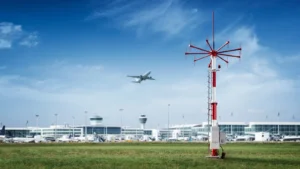What’s an NDB, Anyway?
Ever heard of a Non-Directional Beacon, or NDB for short? It’s like a radio lighthouse for planes and ships! These cool gadgets are low-frequency radio transmitters that help pilots find their way, especially when they’re trying to land at airports or on offshore platforms.
NDBs are pretty neat. They send out signals in all directions, which are picked up by a device in aircraft called an Automatic Direction Finder (ADF). It’s like a compass that points towards the NDB. Pilots tune into the NDB’s frequency, and voila! The ADF shows them which way to go. These beacons are always on, 24/7, and each one has its own special Morse Code call sign – kind of like a radio station’s jingle.
For flying purposes, NDBs follow rules set by the International Civil Aviation Organization. They operate on specific frequencies, which vary depending on where you are in the world. In North America, for example, they use frequencies between 190 and 625 kHz. The main parts of an NDB station on the ground are the beacon transmitter, antenna tuning unit, and antenna.
Most NDBs aren’t super powerful – they usually put out between 25 to 125 watts. That’s enough for planes to pick up the signal from about 100 nautical miles away. Some beefier ones can push out 500 to 1000 watts for longer range. How far the signal reaches depends on a bunch of factors, like the power output, the type of antenna, and even the ground conditions where it’s set up.
Why Are Non-Directional Beacons So Useful?
NDBs are like the reliable old trucks of the navigation world. They can keep running for decades without much fuss, and they’re cheap to set up and run. That’s why they’re the most common navigation aid you’ll find around the globe.
These beacons aren’t just for helping planes land at airports. They also work as markers for more advanced landing systems and help guide planes along standard arrival routes. It’s like having a friendly guide pointing the way home.
NDBs first started popping up offshore in the early 1960s when people began looking for oil in the Gulf of Mexico. Since then, they’ve become standard equipment on offshore platforms and ships used for drilling. They’re super helpful for helicopter pilots and boats that need to find their way to these platforms in the middle of the ocean. It’s like having a lighthouse, but for the air and sea!
